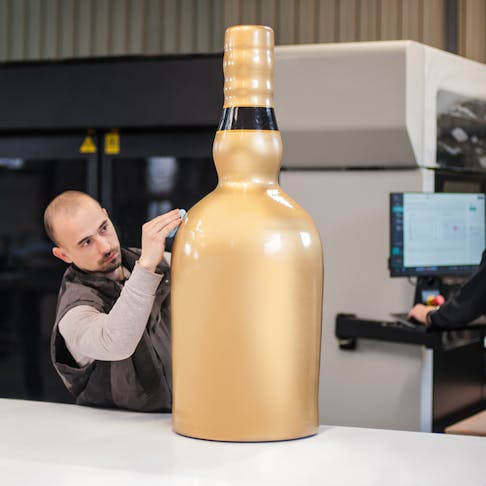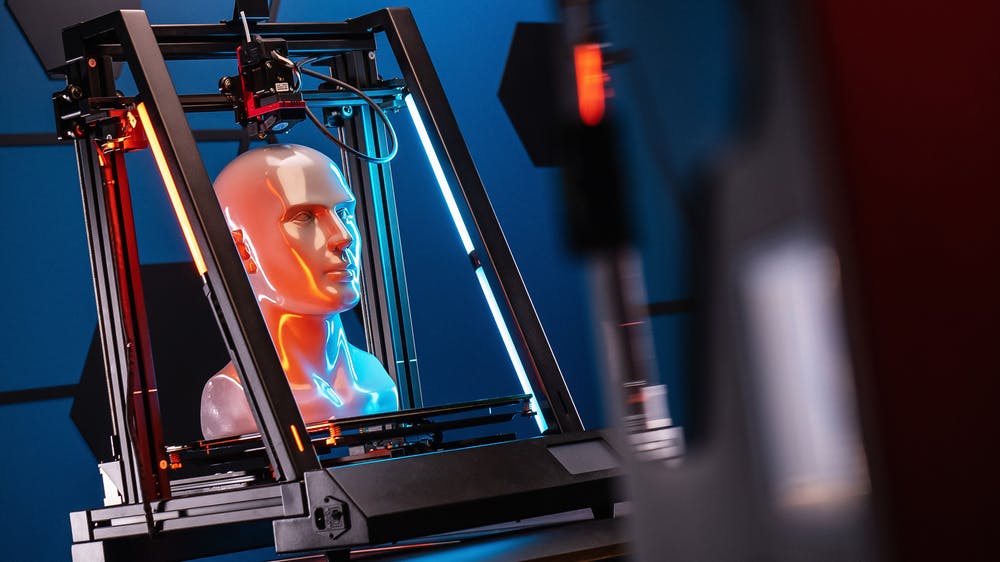
Smoothest 3D Print – How To Smooth 3D Prints

When printing a 3D part, especially if using fused deposition modeling (FDM), the layers of the material will create a rough surface finish. While not having a great effect on the structural properties, roughness does affect the aesthetics. To create smooth 3D prints, post-print processing must be used. There are seven ways in which to smooth a 3D print including using 3D gloop and sanding 3D prints.
Listed below are seven smoothing processes, how they work, and their advantages and disadvantages:
1. Using Paint and Sanding Material
Sanding and painting is the most well-established method used to smooth 3D prints. It is relatively cheap and creates great results, but is labor-intensive. Sanding a 3D-printed part is the same process as sanding other products. Start with a low grit and work your way up to a high grit until you achieve the desired result. Going up to 200 grit sandpaper will create the best results but is very labor intensive. However, if paint is also being used, 200-grit sandpaper likely won't make much difference to the result. To speed up this process, filler can also be used before sanding to reduce the amount of time spent sanding, but this will add weight to the print. Dry sanding is also quicker than wet sanding. However, wet sanding is safer as it prevents the inhalation of dust and it prevents the plastic from melting due to friction. Once sanded, the part can be painted with either spray paint or a paintbrush. Sanding and painting have the advantage of being the cheapest method and give control over the quality of the finish. It is also, however, very labor intensive. The sandpaper will cost up to a maximum of a few dollars per print.
2. Using Abrasive Smoothing Methods
Using tumbling or sandblasting produces varied results. Tumbling a PLA (polylactic acid) print with a vibratory bowl works best and using high-quality PLA can result in a better finish. The quality of the tumbling machine will often also dictate the quality of the surface finish. Sandblasting will also depend on the variables used such as the sand and air pressure used. When using either method, the use of metal or wood-filled PLA will result in a better end product. Using tumbling will require a tumbler; these typically cost a few hundred dollars plus a small amount of electricity for each cycle. But this cost is spread over the many hundreds or thousands of parts the tumbler will smooth.
3. Using XTC-3D
XTC-3D is a low-temperature curing, two-part epoxy resin that is specially designed for smoothing 3D prints. Epoxy resins have a tendency to let off heat when they cure which can warp the print. However, XTC-3D is specially designed to cure at a low temperature to prevent this.
XTC-3D works by mixing a hardener with a resin. This starts a chemical reaction that cures the resin. Once mixed, the resin can be painted onto the part and left to harden. This method of creating smooth 3D prints is relatively simple and effective. The resin leaves a shiny appearance that can be painted. The resin also seals the internals of the print from dirt and liquids. However, resins should only be used in well-ventilated areas while wearing protective equipment as most resins are hazardous to health. The advantages of XTC-3D are: it is easy to apply, creates a gloss surface finish, and seals the print for protection. The disadvantages are: it is expensive, adds weight to the print, will not cure if mixed incorrectly, and can be hazardous to health during curing. XTC-3D costs around $13 per 0.1 kg, and this will cover 0.20 sq meters of the 3D printed surface.
4. Using 3D Gloop
3D gloop is an adhesive specially designed for creating print bead adhesion and sticking printed parts together. But it is also used for smoothing parts printed in ABS (acrylonitrile butadiene styrene), PLA (polylactic acid), and PETG (polyethylene terephthalate glycol-modified) parts. There is no mixing of epoxies necessary; simply paint the gloop from the container to the print. However, the right gloop product must be matched to the material used. For example, the gloop designed for ABS should not be used on PLA. Personal protective equipment must be worn at all times when using the product, and the activity must be carried out in a well-ventilated area. The advantages of gloop are: it is simple to apply, versatile, and specially designed for the application. However, the disadvantage is that it is hazardous to use and adds weight to the print. 3D gloop will cost approximately $55 for 0.113 kg.
5. Using PolyMaker PolySmooth PVB Filament
PVB (polyvinyl butyral) is a type of filament that can be smoothed using isopropyl alcohol once printed. The PVB filament is a low-temperature filament that does not require a heat bed to print. To smooth the print once finished, spray some isopropyl alcohol onto the part and polish it. The alcohol will remove the outer layer of the print leaving a shiny finish. To automate the smoothing process, a polisher can be used. This is a self-contained unit that sprays a fine mist of isopropyl alcohol on the part to smooth it. The advantages of this method are: it is very quick, safe, and consistent. It is a costly method, however. PVB filament is about double the price of PLA, at $50 per 1 kg, and a polisher to evaporate the isopropyl alcohol will cost around $300.
6. Using Chemical Smoothing
The use of chemical smoothing for PLA is difficult and dangerous. The most common chemical used to smooth PLA is ethyl acetate, which is effective at smoothing the surface of PLA. However, ethyl acetate is highly flammable, highly toxic, and difficult to obtain. It would be much safer and easier to use a product such as PVB.
7. Using Heat Gun
The use of a heat gun eliminates the need for using chemicals. This can be safer—however, a heat gun can create a lot of fumes and easily melt the print. This method works by applying heat to the surface of the print whilst constantly moving the heat gun around to ensure the print doesn’t melt too much. Once the surface of the print looks wet and the lines have gone, the part can be left to cool. The advantages of this method are that it is quick, easy, cheap, and leaves a shiny finish. The disadvantages are that it requires a lot of skill and it produces inconsistent results. A heat gun will vary in cost from $20–80.
What Is the Purpose of Smoothing 3D Prints?
The most common reason to smooth a 3D print is to improve the aesthetics of the part. While some methods of smoothing can be time-consuming, they can lead to time saved. Printing a part with a small layer height to better the surface finish can lead to longer print times. However, if a print is made with a greater layer height and then smoothed, it can be quicker. Plus, smoothing will lead to a much better surface finish than FDM can achieve with a fine layer height. Figure 1 is an example of a 3D-printed part with a smooth surface:
Smooth 3D printed part.
Image Credit: Shutterstock.com/Hodoimg
What Is the Commonly Used Method To Smoothen PLA 3D Prints?
The most common way to smooth a 3D print is sanding. This is because it is cheap, easy, and produces the best results, although it is very time-consuming. There are also popular ways to smooth with the use of XTC-3D, printing gloop, and PVB. Then there are more uncommon ways, often leading to a lack of success, such as using a heat gun, ethyl acetate, tumbling, and sandblasting.
What Paint To Use on PLA 3D Prints?
When painting PLA, it is best to use acrylic or enamel paints. Both types of paints can be brushed on or sprayed. Acrylic paints are water-based, easy to use, quick to dry, and have a matte finish. Enamel paints are oil-based and have a stain-resistant shell increasing durability. Enamel paints will have a glossy finish.
What Is a 3D PLA Print?
A 3D PLA print refers to a part that is made using an additive method in which layers of material are added to create a 3D part. This differs from more traditional methods such as milling and machining where the material is taken away. The most common 3D printing method is FDM, in which a filament is extracted from a printhead that layers up material on a print bed. However, other methods exist such as resin printing which cures layers of resin to a print bed as the bed slowly moves up and out of the resin bed. There is also the printing of other materials such as: ABS, ASA (acrylonitrile styrene acrylate), or PET (polyethylene terephthalate). For more information, see our guide on PLA for 3D printing.
Why Is the 3D Printing Surface Is Not Smooth?
A 3D printed part using FDM printing creates a rough surface because it is printed in layers. This means that no matter how good the printer is, each layer will be a slightly different shape. This leads to the layers being slightly misaligned and creating a rough surface. The roughness of the surface can be minimized with the right print settings and a high-quality printer. However, using a post-printing process will yield the best surface finish.
What Happens if You Soak PLA in Water?
Not much happens when soaking PLA in water. Although PLA will absorb water over time, it does take a long time to degrade. PLA will absorb water much faster than other plastics as it is made from biodegradable material, unlike other polymers. The time required to degrade PLA can be accelerated with exposure to high water temperature and UV light. Over time, PLA will swell and weaken as it absorbs water. When PLA absorbs water, it will also significantly increase in weight. Similarly, PLA will also absorb water from the atmosphere over long periods if exposed. It can equally be dried out in an oven or dehydrator.
Is Alcohol Able To Smooth 3D Prints?
Yes, alcohol can smoothen 3D-printed parts. However, this depends on the material. Previously, the most common 3D printed material was ABS which can be easily smoothed using isopropyl alcohol. Now, the most common material is PLA which cannot be effectively smoothed using isopropyl alcohol, except PolySmooth™. PolySmooth™ is a brand of PLA that becomes soluble when exposed to isopropyl alcohol.
Is Acetone Able To Smooth PLA 3D Prints?
No, acetone cannot smoothen PLA 3D prints. While technically, it can dissolve PLA, PLA acetone smoothing is not an effective method. More often than not, acetone will rubberize the surface of a PLA print, ruining the surface finish and degrading the strength of the part in the process. Acetone is also much more hazardous than other smoothing methods. Acetone, however, is very good at smoothing ABS prints.
Can You Sand 3D Prints To Smooth?
Yes, you can sand a 3D print smoothly. Sanding a 3D print smooth is one of the most used methods as it is cheap, safe, relatively easy, and creates great results, even if it is very labor intensive. Usually, after sanding, parts are also painted with acrylic or enamel paint which will reduce the amount of sanding necessary as the paint will smooth out a slightly rough surface.
Summary
This article presented smooth 3D prints, explained them, and discussed the various processes and advantages. To learn more about smooth 3D prints, contact a Xometry representative.
Xometry provides a wide range of manufacturing capabilities, including 3D printing and other value-added services for all of your prototyping and production needs. Visit our website to learn more or to request a free, no-obligation quote.
Copyright and Trademark Notices
- PolySmooth™ is a trademark of Polymaker (Headquartered in Changshu, China)
Disclaimer
The content appearing on this webpage is for informational purposes only. Xometry makes no representation or warranty of any kind, be it expressed or implied, as to the accuracy, completeness, or validity of the information. Any performance parameters, geometric tolerances, specific design features, quality and types of materials, or processes should not be inferred to represent what will be delivered by third-party suppliers or manufacturers through Xometry’s network. Buyers seeking quotes for parts are responsible for defining the specific requirements for those parts. Please refer to our terms and conditions for more information.

